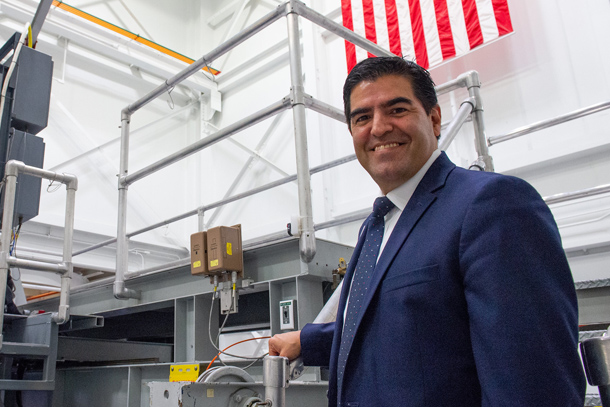
Jean Paul Allain, head of the Ken and Mary Alice Lindquist Department of Nuclear Engineering at Penn State, has been appointed to a two-year term to lead the Fusion Energy Sciences program within the U.S. Department of Energy’s Office of Science. Credit: Penn State
Jean Paul Allain to lead DOE Fusion Energy Sciences program
May 16, 2023
This article originally appeared on Penn State News. Jean Paul Allain, head of the Ken and Mary Alice Lindquist Department of Nuclear Engineering at Penn State, is featured.
UNIVERSITY PARK, Pa. — Jean Paul Allain, head of the Ken and Mary Alice Lindquist Department of Nuclear Engineering at Penn State, has been appointed associate director for fusion energy sciences (FES) within the U.S. Department of Energy’s (DOE) Office of Science. Over a two-year term, in accordance with the provisions of the Intergovernmental Personnel Act, Allain will serve in a senior executive role and will lead in the planning, development and administration of research programs in fusion energy science. He also will lead the coordination of such activities with the research needs of the DOE, as well as with the fusion energy sciences programs of other government agencies supporting basic energy sciences research.
Allain will serve as an adviser to DOE senior leadership on fundamental scientific topics and initiatives supported by the FES program to maintain DOE’s and the United States’ leadership in fusion energy sciences and fundamental plasma science and to help accelerate commercial fusion energy.
“It is both a blessing and honor to be able to serve my country in this capacity, as this decade is arguably one of the most consequential for nuclear energy, and nuclear fusion plays a critical role in the delivery of a diverse and versatile resource of nuclear technologies at the disposal of our nation and the world,” Allain said. “The chance to lead the FES and bring the most emergent scientific discoveries in plasma physics and fusion technology to the forefront of energy transition is one of the most exciting aspects of this opportunity. I look forward to working closely not only with my colleagues in our fusion scientific community and the Office of Science but with all stakeholders in realizing President [Joe] Biden’s bold decadal vision of developing a strategy to accelerate fusion energy to our grid and beyond, helping to achieve net-zero emissions by 2050.”
The Office of Science is the largest supporter of basic research in the physical sciences in the United States, providing more than 40% of total funding in this area. It oversees and is the principal federal funding agency of the nation's research programs in high-energy physics, nuclear physics, fusion energy sciences, materials and chemical sciences, biological and environmental sciences and computing sciences, and it also supports important parts of U.S. research in climate change, geosciences, life sciences and science education.
“We are thrilled to have Dr. Allain join the DOE Office of Science to lead the Fusion Energy Sciences program,” said Asmeret Asefaw Berhe, director of the DOE’s Office of Science. “The experience he brings from Penn State will benefit U.S. science, and we look forward to him leading us in the next chapter of fusion research.”
With an annual budget of $720 million, the FES program’s mission is to expand the fundamental understanding of matter at very high temperatures and densities and to build the scientific foundation needed to develop a fusion energy source. This is accomplished through the study of plasma, the fourth state of matter, and how it interacts with its surroundings.
Allain will be taking over the FES at an unprecedented time with more than $5 billion in private equity investment in nuclear fusion startups, the achievement of nuclear fusion ignition demonstrated at the National Ignition Facility at Lawrence Livermore National Laboratory, and Biden’s bold decadal vision unveiling in 2022 to support fusion development toward a fusion pilot plant in the 2030s.
As department head at Penn State, Allain led an expansion of nuclear engineering faculty by more than 60% over three years and helped expand instructional and experimental facilities for nuclear and plasma science and technology with investment, recruitment and operational budgets totaling more than $30 million. Under his leadership, extramural funding also has grown to more than $26 million. This year, the department graduated the nation’s second largest class in nuclear engineering.
“Dr. Allain is a leading researcher in plasma-material interactions and fusion technology, who has successfully translated his research to plasma engineering applications in multiple fields,” said Justin Schwartz, Penn State executive vice president and provost. “He is also an effective mentor, guiding junior faculty and advising countless students, with the goal of contributing both significant research and strong researchers to the nuclear engineering community.”
With funding from DOE FES, DOD and NSF totaling more than $16 million over the past 18 years, Allain has applied his research to plasma medicine, regenerative medicine, natural biopolymers, nanomaterials, compound semiconductors, bulk metallic glasses and high-temperature alloys. He has served on more than 25 DOE study and national panels and subcommittees. His scholarship in nuclear fusion plasma-material interactions includes more than 162 peer-reviewed publications, more than 200 proceedings, 120 invited talks, 400 contributed presentations, five book chapters and 10 patents. Allain also has founded two companies, Energy Driven Technologies LLC and Editekk Inc., raising more than $2.1 million in entrepreneurial and innovation funding.
“Dr. Allain has been a foundational driver of Penn State’s nuclear engineering program and is one of the finest leaders, mentors and engineers in this industry,” said Lora Weiss, senior vice president for research at Penn State. “His unyielding commitment to advancing technologies such as micronuclear reactors has been profound. We look forward to seeing the advances he will make in this position, where he will drive innovations in our nation’s fusion energy sciences during a pivotal time in research on emerging energy solutions.”



